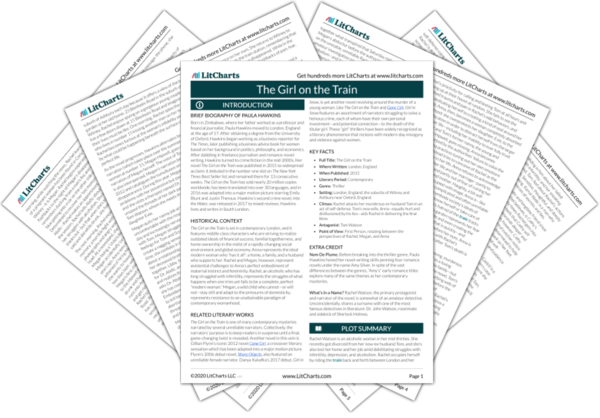Women and Society
Paula Hawkins’s The Girl on the Train is a novel about how society’s expectations of women often push them to the breaking point, leading them to seek out (or fall victim to) dangerous situations. As Rachel Watson struggles to understand her role in the disappearance of a young and beautiful woman from an outer suburb of London, Megan Hipwell, Hawkins suggests that society is structured to overwhelm, overburden, and then ultimately abandon women in…
read analysis of Women and SocietyGaslighting, Memory, Repression, and the Self
In The Girl on the Train, Paula Hawkins follows three women who are abused by the men in their lives in the form of what’s called gaslighting: manipulation through questioning or invalidating a person’s sanity. The novel’s antagonist-in-disguise, Tom Watson, is an expert at this kind of phycological abuse—yet Hawkins also shows how women at times gaslight themselves by internalizing their struggles—societal pressures, abuse they’ve suffered, or self-hatred—to the point of self-destruction. Hawkins…
read analysis of Gaslighting, Memory, Repression, and the SelfAddiction, Dependency, and Abuse
Throughout The Girl on the Train, the novel’s protagonist and primary narrator, Rachel Watson, endures a painful and life-threatening battle with alcoholism. But Rachel isn’t the only character in the novel who struggles with addiction; Hawkins examines how Rachel, Megan, and Anna—all survivors of Tom Watson’s cruelty and abuse—develop patterns of addiction and dependency to cope with or attempt to escape that abuse. Ultimately, by interweaving stories of three women…
read analysis of Addiction, Dependency, and Abuse
Secrets and Lies
Paula Hawkins’s The Girl on the Train is an intricate and suspenseful modern-day mystery in which none of the main characters—not even the protagonist, Rachel Watson—is particularly reliable. In the world of the novel, truth is constantly obscured, and any information that comes to light is immediately subject to suspicion and uncertainty. Through the creation of this environment, Hawkins ultimately suggests that a relationship, a community, or indeed a society rooted in secrets and…
read analysis of Secrets and LiesMotherhood, Duty, and Care
Throughout The Girl on the Train, the novel’s three main characters—Rachel, Megan, and Anna—all struggle with motherhood in different ways as they attempt to embody society’s idea of a good mother. Rachel feels like a failure as a woman because she cannot have a child. Megan, having botched motherhood once, now finds the idea of caring for a child repugnant and frightful. Anna, who uses motherhood as an outlet for…
read analysis of Motherhood, Duty, and Care






